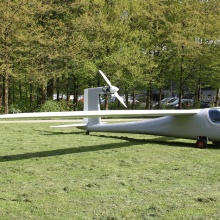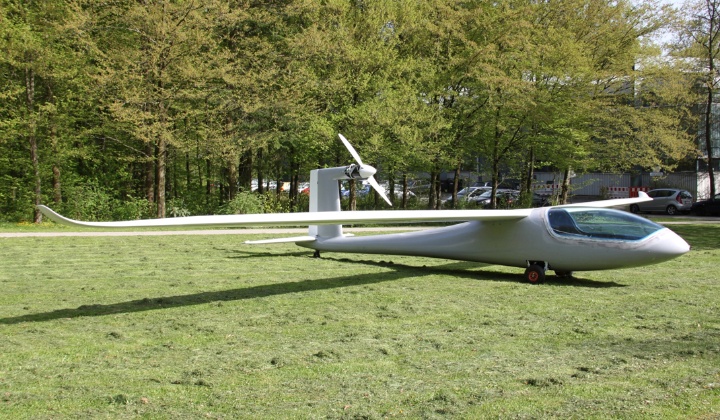The task at the Berblinger Flight Competition 2011, which takes place in Ulm from 15th until 17th April, is flying using innovative technologies. The electric aircraft „e-Genius“ from the Faculty of Aerospace at the University of Stuttgart will also be involved. The e-Genius is a two-seater aircraft especially developed for efficient electrically powered flights manufactured in a carbon fibre plastic design. With a 60 kW electric motor the aircraft achieves a range of up to 400 kilometres, thereby only consuming 4,75 kilowatt hours (this corresponds to 0,6 litres of petrol) per 100 kilometres and passenger. E-Genius is a further development of the fuel cell aircraft Hydrogenius, with which the team around Prof. Rudolf Voit-Nitschmann already won the Berblinger Competition in 2006. A battery system was used to equip it.
„Our most important goal was to demonstrate the efficiency of a modern electric aircraft without
making any compromises and not being willing to accept economising with the flight performance in
terms of today’s state of the art technology“, explained Prof. Voit-Nitschmann. Therefore, the
requirements were a highly efficient electrical drive system, a cruising speed of between 140 and
235 kilometres per hour and, depending on the energy storage system, a range of several hundred
kilometres. In addition the two-seater was to manage with a take-off distance of below 600 metres
with a maximum take-off weight of 850 kilograms and be as manageable as existing touring motor
gliders.
Therefore the team, which also includes the project assistants Len Schumann and Steffen
Geinitz, trod completely new paths to realise e-Genius and to redesign the integration of the whole
electrical drive train in particular. The drive is now in the rear, which enables efficiency
improved by 15 to 20 percent, a compact and light retractable landing gear as well as an
uninterrupted view forwards. The fuselage was created in a carbon fibre sandwich design, making it
extremely light. The concept of the cockpit ensures comfort and creates storage space for energy
storage devices behind the pilots’ seats.
The drive system of the Hydrogenius platform and in particular the e-Genius version is
specifically oriented towards the requirements of electric flying and simultaneously enables an
extremely environmentally sustainability and safe aircraft. In this respect the 25 by 28 cm and
only 27 kilogram engine reaches 2,500 rotations/minute with a continuous output of 58 kilowatt and
thus provides a peak torque limiter of 400 Newton metres. The energy for the permanently excited
synchronised motor is provided by a converter, which is water-cooled, just like the engine itself.
Through this the loss of heat can be discharged in a targeted way and be emitted more efficiently
via a heat exchanger. The efficiency of converter and electric engine together reaches values of up
to 95 percent through a further area of application and still manage to reach over 90 percent even
with full load.
The part of the drive system directly responsible for the propulsion is being supplemented by
a propeller, which was developed purely for the Hydrogenius platform. This is designed as a
variable pitch propeller due to the large speed area and positioned in the rear. This allows a
larger diameter compared to conventional propellers, which reduces noise emissions due to the
higher level of efficiency and a reduced number of rotations.
With a view to the future development in aviation in general e-Genius shows that it is more effective to develop and optimise an aircraft especially for electric flights than to reequip conventional aircraft concepts. Only in this way is it possible to use the advantages of electric drive and to counter the disadvantages with correspondingly constructive measures. E-Genius consequently represents an uncompromising approach in order to realise environmentally sustainable and economic flying using today’s state of the art technology. Testing the e-Genius is intended to confirm the concept but also to reveal the weak points. This data is important for possible future serial products but also for licensing these innovative aircraft by the aviation authorities. Consequently the project contributions can be a forerunner for the Berblinger Prize 2011 for a future generation representing electrically driven, environmentally sustainable serial aircraft. Added to this is the high level of efficiency due to low consumption costs. In this respect the price to „fill up a tank“ should be around 12.30 Euros on the basis of the current energy prices.
The international Berblinger Flight Competition was held by the city of Ulm for the first time in 1986 on the occasion of the 175th return of the flight attempt by Alfred Ludwig Berblinger, the tailor of Ulm. Prof. Voith-Nitschmann and his team already won the prize in 1996 with the solar plane Icaré and in 2006 with the fuel cell aircraft Hydrogenius.
Further information from Prof. Rudolf Voit-Nitschmann, Institut für Flugzeugbau, Tel.
0711/685-62770, e-mail: rvn@ifb.uni-stuttgart.de
www.ifb.uni-stuttgart.de/index.php/forschung/flugzeugentwurf/hydrogenius/300
www.berblinger.ulm.de



